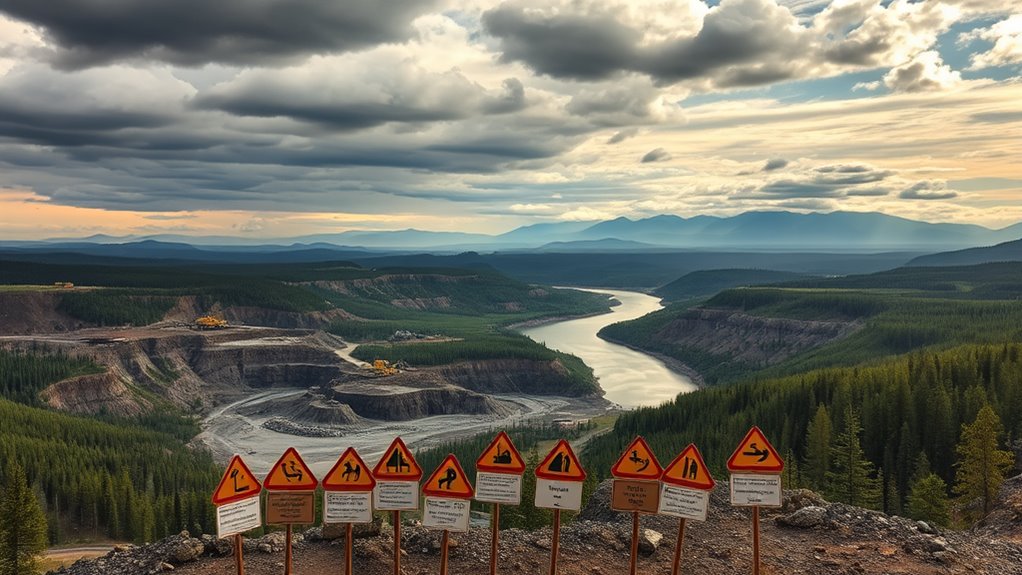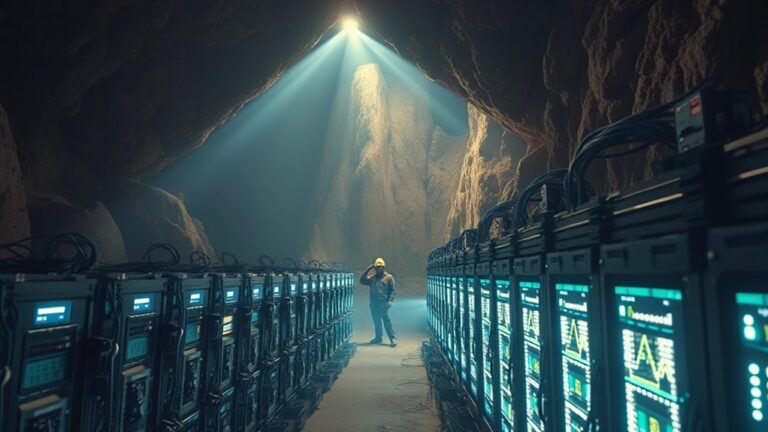
Regulations and Legal Status of Mining: A Global Overview
The regulations and legal status of crypto mining vary widely around the world. While most countries permit mining, they also impose specific regulations focused on consumer protection and environmental sustainability. For instance, the United States and Canada have established tailored frameworks, while the European Union’s MiCA regulation provides extensive guidelines. As environmental impact continues to be a concern, governments are tightening rules and promoting renewable energy within this sector. More insights into these developments can be explored further.
Key Takeaways
- Crypto mining is generally permitted worldwide, but regulations vary significantly by country and region.
- Jurisdictions like the U.S., Canada, and Australia have specific frameworks addressing mining activities and customer protection.
- Environmental regulations are tightening, with governments promoting sustainable practices to mitigate mining’s ecological impact.
- Compliance with local laws, including tax obligations and record-keeping, is essential for miners in most regions.
- There is a growing emphasis on transparency and accountability in the mining sector to address environmental concerns.
Overview of Crypto Mining Regulations

Crypto mining regulations are an essential aspect of the broader cryptocurrency landscape, as they govern the legal framework within which mining activities operate. The legal status of crypto mining varies globally, with most jurisdictions permitting it.
However, governments focus on customer protection and preventing illegal activities, leading to differing regulations. For example, the U.S., Canada, and Australia are significant players in the mining industry, each with tailored frameworks.
The European Union’s MiCA regulation serves as a thorough guide for crypto assets. Meanwhile, countries like China have imposed strict bans due to concerns over energy consumption. As the industry evolves, regulations are expected to adapt, emphasizing compliance and consumer safety while addressing emerging challenges in the global market. Recent developments in innovation-friendly regulations suggest a potential shift in how mining activities may be viewed in various jurisdictions.
Environmental Impact and Compliance

The environmental impact of mining activities, particularly those associated with cryptocurrencies, raises significant concerns that are increasingly being addressed through regulatory compliance measures.
Mining, especially Bitcoin, contributes approximately 86 megatons of CO2 emissions annually, exacerbating global climate change. Additionally, the large-scale operations often lead to land displacement and require substantial water usage, with about 1.65 million liters consumed between 2020 and 2021.
To alleviate these impacts, governments are implementing stricter regulations and promoting the use of renewable energy. Community engagement and technological innovations are also crucial for compliance. Furthermore, sustainable mining techniques such as in-situ leaching can help reduce surface disturbance and environmental damage.
Regular monitoring and reporting of environmental effects guarantee accountability, while non-compliant operations face penalties, highlighting the need for a balanced approach to mining and environmental sustainability.
International Legal Framework for Crypto Mining

As the popularity of cryptocurrency continues to grow, understanding the international legal framework surrounding mining activities becomes increasingly important. Most countries permit crypto mining, but regulations are tightening, with oversight from bodies like the SEC and IRS in the U.S.
High energy consumption has led regions such as New York and Manitoba to impose restrictions. Miners often relocate to areas with favorable laws and lower energy costs, particularly after China’s crackdown.
Tax obligations vary; in the U.S., mining profits are taxed as self-employment income, while Australia imposes capital gains tax. Compliance requires meticulous record-keeping and adherence to local laws, emphasizing the need for miners to stay informed about evolving regulations in their respective jurisdictions.
Transparency and Accountability in the Crypto Mining Sector

In recent years, the need for transparency and accountability in the crypto mining sector has gained significant attention, particularly as the international legal framework surrounding cryptocurrency continues to evolve.
Current regulatory challenges reveal a lack of explicit laws, leading to concerns about environmental impacts and public health. For instance, the U.S. Energy Information Administration (EIA) is working on reporting requirements for energy consumption, which is critical for evaluating the sector’s environmental effects.
Legislation like the Crypto-Asset Environmental Transparency Act aims to enforce emissions disclosure from large mining operations, promoting accountability.
Additionally, public awareness initiatives are essential for informing consumers about the industry’s environmental consequences, fostering a demand for clearer regulations and responsible practices in cryptocurrency mining. Moreover, addressing mining scams is crucial to ensure a safe and sustainable industry that protects investors and promotes ethical practices.
Emerging Trends and Future Challenges in Crypto Mining Regulations

Emerging trends in cryptocurrency mining regulations reflect a growing recognition of the need for a balanced approach that addresses both innovation and environmental concerns.
As governments worldwide prioritize thorough regulations, there is an increased focus on the environmental impact of mining activities, particularly regarding energy consumption and climate change.
Regulatory bodies, such as the SEC in the U.S., are enhancing enforcement against non-compliant entities, while countries grapple with cross-border challenges and divergent national policies.
The need for harmonized global standards is becoming apparent to guarantee consistency in regulatory practices.
Additionally, innovative solutions like regulatory sandboxes are being employed to foster technological advancements while maintaining oversight, highlighting the delicate balance between regulation and innovation.
Moreover, the shift towards renewable energy sources in mining practices is crucial for aligning with regulatory goals and promoting sustainability.
Frequently Asked Questions
How Do Mining Regulations Vary by Country?
Mining regulations differ markedly across countries, addressing aspects such as environmental impact, safety protocols, and local content requirements. Each nation implements unique legislation tailored to its specific resources, priorities, and socio-economic contexts, influencing global mining practices.
What Penalties Exist for Non-Compliance With Mining Laws?
Penalties for non-compliance with mining laws vary widely, including financial fines, enforcement actions, and potential criminal charges. Factors such as violation severity, environmental impact, and local regulations greatly influence the penalties imposed.
How Are Indigenous Rights Protected in Mining Regulations?
Indigenous rights in mining regulations are increasingly protected through principles like Free, Prior, and Informed Consent (FPIC), emphasizing self-determination. However, challenges remain due to outdated laws and inadequate enforcement of these rights globally.
What Role Do NGOS Play in Mining Regulation Enforcement?
NGOs play an essential role in mining regulation enforcement by monitoring compliance, advocating for policy reforms, enhancing community engagement, and promoting transparency. Their efforts help guarantee that environmental and social standards are upheld throughout mining operations.
How Can Communities Influence Mining Policy Decisions?
Communities can influence mining policy decisions like a river carving its path through rock, steadily shaping the landscape. Through engagement, local insights guide equitable policies, ensuring mining practices align with their unique socio-economic and environmental contexts.
Conclusion
As the landscape of crypto mining regulations continues to evolve, an essential question lingers: how will countries balance the need for innovation with environmental responsibility? The international legal framework remains fragmented, creating uncertainty for miners. Emerging trends suggest that increased transparency and accountability may be on the horizon, yet challenges persist. Will regulators find a sustainable path forward, or will the industry face stricter limitations? The future of crypto mining hangs in the balance, awaiting decisive action.












